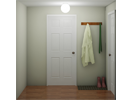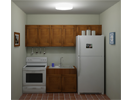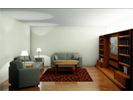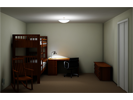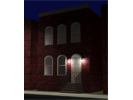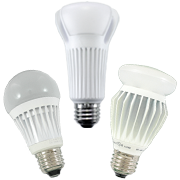
LEDs for General Lighting
Light-emitting diodes (LEDs) can be used for ambient lighting to provide general, diffuse illumination for a space. Screwbase LED replacement bulbs fit into the same medium-based sockets as common incandescent bulbs. Fixture-integrated LEDs, including downlights, track lights, and nightlights are also available. The list of LED lighting products is expanding rapidly.
One of the benefits of LED products is their high efficacy (the amount of light produced per unit of input power). LED efficacy has increased over time, and recently has begun to surpass that of CFLs, formerly the most efficacious bulb replacement used in residences. Because of their high efficacy, LED products may still have a lower cost of ownership despite a higher initial price than other bulbs. Use the economic calculator to determine the cost savings of a particular lighting design.
In addition to potentially saving money, the high efficacy of LEDs leads to reduced emission of carbon dioxide and other pollutants from power plants. Also, they are free of mercury, a toxic metal found in fluorescent light sources.
Another advantage for LEDs is lower surface temperature. LEDs are typically less hot to the touch than conventional incandescent sources, and therefore could be suitable for areas where people may touch them, such as a in desk lamp in a child's bedroom.
Manufacturers typically rate LED products for long life, often in the 25,000 to 50,000 hour range. Long life has the benefit of reducing the cost of ownership and decreasing the number of times a light bulb needs to be changed in hard-to-access locations. Two caveats should be kept in mind regarding LED life. First, the life is determined for the LED itself, but there are other electronic components that may fail first. Second, LED life (and light output) is strongly dependent on its temperature. This is why LED products sometimes have metal fins: to extract heat from the device and radiate it across a larger surface area. It is important to read the manufacturer's guidelines for where an LED product can be installed. For example, a product should not be installed in an insulated ceiling or in an enclosed fixture unless it is rated for that application by the manufacturer.
It can be difficult to tell when an LED product should be replaced because they generally do not fail by burning out but will slowly reduce in light output over time; as solid state devices, LEDs will continue to operate even after many thousands of hours, continuing to use electrical power even if they produce very little useful light. Therefore, the lighting industry developed a specialized definition for LED bulb life. This term ("L70") is defined as the amount of time at which light output has degraded by 30% compared to initial output. (For incandescent and fluorescent light sources, the life is the time (in hours) at which half of the test samples have burned out.)
Many LED products are dimmable when paired with the right equipment, and are available in similar color temperatures and color rendering as fluorescent and incandescent sources.
Cautions
- LED products are often heavier than conventional light sources (to allow for heat management). This may lead to sagging or unstable light fixtures.
- To protect them from getting too hot, many LED products should not be installed in enclosed or insulated areas or over heat sources such as stoves. Refer to manufacturer specifications for acceptable installation locations for a particular product.
- If you have a fixture with a three-way or other multi-level switch, make sure the bulb packaging states that it is compatible.
- Keep the receipt and packaging for LED products in case they fail during the warranty period.
- If an LED product will be used with a dimmer, make sure the package states that it is dimmable.
- Some LED bulbs emit light less evenly in all directions than an incandescent bulb. After installation, check for sufficient illumination where it is needed.
Additional Information
LED Lighting: An interactive video presentation
LED lighting can provide energy efficient, high quality lighting in many settings. The Lighting Research Center and NYSERDA present the following interactive video to assist contractors, building professionals, and other lighting installers with the often confusing process of selecting and installing solid-state lighting equipment for a particular application. Topics of the video include product selection, advantages and challenges of LED products, economic calculations, installation tips, and links to other available resources. Viewers can earn professional continuing education credits by watching the video and using the interactive features. Adobe Flash and a broadband internet connection are required.
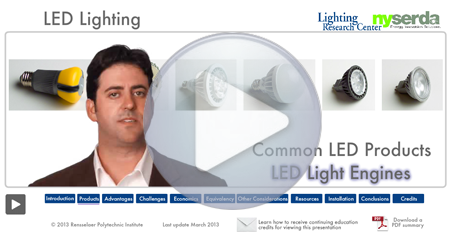
- (Note: You must have Flash Player 11 or later installed to view the presentation. Click here to download Flash player.)
Example Patterns
